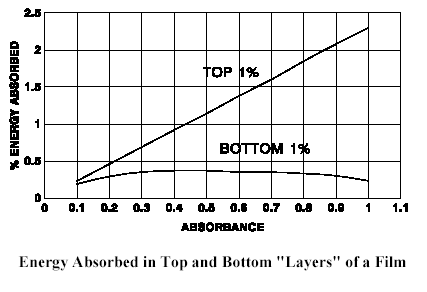Guide to UV Measurement
Absorbance and Irradiance
All inks, coatings, or adhesives will absorb the UV arriving at the surface, but the radiant power available deeper within the film will depend on the absorption in the film. The higher the radiant power at the surface, the higher the power at any depth within the material.
The reduction of radiant energy (light or UV) as it passes into or through any material is described by the Beer-Lambert law. Only energy that is not absorbed in an upper layer of the film (nor reflected) is transmitted and available to lower layers.

Ioλ is the incident radiant flux rate (irradiance) at wavelengthλ, Iaλ is the flux absorbed, Aλ is absorbance at wavelength λ, and d is the depth from the surface or film thickness. (Note that since the time of exposure of Io and Ia are exactly the same, the expression is the same for units of energy, E , or irradiance, I.)
An examination of this equation reveals the relative energy absorbed in the top surface (1% layer) and the extreme bottom (1% layer) of a film, as a function of absorbance. There is a great difference in the photon flux in these two zones!

Calculation further shows that the "optimum" (theoretical) absorbance of a film of any thickness is 0.4 to 0.43. In other words, the maximal absorption in the bottom layer occurs when there is a "best" combination of film thickness and absorption. (ref) As we see, this "ideal condition does not often occur in practical inks and coatings, as it represents a very low absorbance (very transparent) film. Figure 1 also illustrates that even at the best conditions, energy absorbed at the top surface is 2½ to 3 times the energy absorbed at the bottom! For a film with an absorbance of 3.0, this ratio of top to bottom power is approximately 1 thousand!
For any specific wavelength, the only way to increase Ia (photon fluence rate) at any depth is to increase irradiance, Io, at the surface.